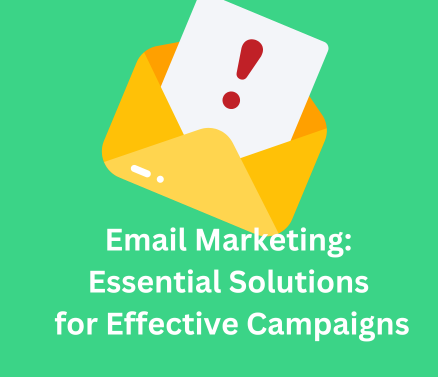
Email Marketing: Essential Solutions for Effective Campaigns
Email marketing remains one of the most effective strategies for engaging with your audience, nurturing leads, and driving conversions. However, to achieve success in your email marketing efforts, utilizing the right tools is crucial. These tools can help you design compelling emails, automate campaigns, track performance, and manage your subscriber lists. Here’s a comprehensive guide to the top email marketing tools that can elevate your campaigns and drive results
Table of Contents
- 1. Choose the Right Email Marketing Platform
- 2. Leverage Automation Tools for Efficient Campaigns
- 3. Utilize Analytics Tools to Measure Performance
- 4. Enhance Personalization with Advanced Segmentation
- 5. Design Stunning Emails with Drag-and-Drop Builders
- 6. Ensure Deliverability with Spam Testing Tools
- 7. Integrate with CRM for Better Lead Management
- 8. Optimize Campaigns with A/B Testing Features
- 9. Track Engagement with Detailed Reporting Tools
- 10. Utilize Templates and Design Resources
1. Choose the Right Email Marketing Platform
Selecting the right email marketing platform is the first step in optimizing your email campaigns. Platforms like Mailchimp, Sendinblue, and Constant Contact offer a range of features, including customizable templates, list management, and campaign tracking. Evaluate your needs based on the size of your email list, the complexity of your campaigns, and your budget. Choose a platform that provides the functionalities you require and integrates seamlessly with other tools you use.
2. Leverage Automation Tools for Efficient Campaigns
Automation tools can significantly enhance the efficiency of your email marketing campaigns. Tools like HubSpot and ActiveCampaign allow you to set up automated workflows for welcome emails, drip campaigns, and follow-ups. Automating these processes saves time and ensures that your audience receives timely and relevant content. Implement triggers based on user behavior, such as website visits or cart abandonment, to send personalized messages that drive engagement and conversions.
3. Utilize Analytics Tools to Measure Performance
Analytics are crucial for understanding the effectiveness of your email campaigns. Tools like Google Analytics and the built-in analytics features of email platforms provide insights into open rates, click-through rates, bounce rates, and conversions. Analyze these metrics to gauge the performance of your campaigns and identify areas for improvement. Use the data to refine your strategies, optimize content, and enhance your overall email marketing efforts.
4. Enhance Personalization with Advanced Segmentation
Personalization is key to engaging your audience and improving response rates. Advanced segmentation tools allow you to categorize your email list based on demographics, behavior, and preferences. Platforms like Mailchimp and Drip offer robust segmentation features that help you target specific groups with tailored content. Create segments based on user interests, purchase history, or engagement levels to deliver relevant messages that resonate with each recipient
5. Design Stunning Emails with Drag-and-Drop Builders
Email design tools play a crucial role in creating visually appealing and effective emails. Drag-and-drop builders, such as those offered by Campaign Monitor and AWeber, make it easy to design professional-looking emails without needing coding skills. Customize templates, add images, and adjust layouts to match your brand’s style. A well-designed email can capture attention, convey your message effectively, and drive higher engagement rates.
6. Ensure Deliverability with Spam Testing Tools
Ensuring that your emails reach your recipients’ inboxes is vital for the success of your campaigns. Spam testing tools like Litmus and Email on Acid help you identify potential issues that may affect deliverability. Test your emails for common spam triggers, formatting issues, and compatibility with different email clients. By addressing these factors, you can improve the chances of your emails landing in the inbox rather than the spam folder.
7. Integrate with CRM for Better Lead Management
Integrating your email marketing tools with a Customer Relationship Management (CRM) system can streamline lead management and enhance your campaigns. Tools like Salesforce and Zoho CRM offer integration options that allow you to synchronize your email list with your CRM database. This integration provides a comprehensive view of your leads, enables better segmentation, and allows for more targeted and personalized email campaigns.
8. Optimize Campaigns with A/B Testing Features
A/B testing is a valuable technique for optimizing your email campaigns and improving performance. Email marketing platforms like Benchmark Email and ConvertKit offer A/B testing features that allow you to test different subject lines, content, and calls to action. Analyze the results to determine which variations perform best and use these insights to refine your future campaigns. A/B testing helps you make data-driven decisions and enhance the effectiveness of your email marketing efforts.
9. Track Engagement with Detailed Reporting Tools
Detailed reporting tools provide valuable insights into how your audience interacts with your emails. Track metrics such as open rates, click-through rates, and engagement levels to assess the impact of your campaigns. Platforms like GetResponse and Moonsend offer comprehensive reporting features that allow you to analyze user behavior and measure the success of your email marketing strategies. Use these reports to identify trends, understand audience preferences, and make informed decisions.
10. Utilize Templates and Design Resources
Templates and design resources can save time and ensure consistency in your email campaigns. Many email marketing platforms provide a library of customizable templates for different types of emails, including newsletters, promotions, and announcements. Explore these templates to find designs that align with your brand and campaign goals. Additionally, utilize design resources such as stock images, icons, and fonts to enhance the visual appeal of your emails.
Conclusion
Effective email marketing relies on the right tools to design, automate, analyze, and optimize your campaigns. By choosing the right platform, leveraging automation, and utilizing analytics, you can enhance your email marketing efforts and achieve better results. Incorporate advanced segmentation, design stunning emails, and ensure deliverability to maximize the impact of your campaigns. Regularly monitor performance and adjust strategies based on insights to continually improve your email marketing success. Implement these tools and strategies to create compelling email campaigns that engage your audience and drive conversions.
Leave a comment